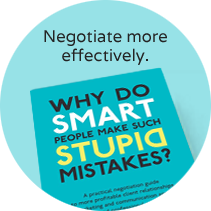Insights

Right from day 1: What happens after the honeymoon?
Essential strategies to ensure your new client relationships are growing, not groaning, 12 months later.
Your boss congratulates you on the new client you have just won. The champagne corks fly and the future is looking rosy. Your career is going in one direction, up. Now let’s roll forward 6 months and the honeymoon period with the new client is over. The relationship is strained. The tension is just below the surface. The early signs of the relationship derailing are apparent. You ask yourself “what went wrong?”
Relationships with clients are in a state of movement, moving either upwards or downwards. They are very rarely static. To improve a relationship requires us to make a conscious decision to improve and make a conscious effort. Superficial improvements will be spotted very quickly by the client. Authenticity will be vital.
In the early days of a business relationship during the ‘honeymoon’ stage there are high expectations on either side. Like a love affair we seek to impress. Leaving the development of the relationship to chance will be a mistake. It is better to be proactive and anticipate what might go wrong and pre-empt any potential problems. Prevention is always better than cure.
The paradox is that in our attempt to please the client in the early days we over-service the business, go above and beyond the line of duty and set precedents which will affect the business relationship in the future. I define a precedent as “short term generosity with long term implications”. The over-service in the early days creates unrealistic expectations for the client that will continue into the future, unless we maintain that higher level of service. Over-servicing is a common mistake made by rookies and also many senior people.
What kind of relationship exists between you and your client? Are you in a “buyer-supplier’ relationship which is transactional and the focus is on price and just ‘do’? Or are you in a peer to peer relationship based on your expertise and your value where clients see you as a partner or a trusted adviser? The right relationship, peer to peer, needs to start from Day1. You have to earn a peer to peer relationship based on your expertise, advice and value contributed.
Trust is a crucial component to be nurtured from Day1. Trust takes time to build and yet can be lost in a heart-beat. Trust builds confidence. No trust, no sale. So trust must be there on Day1. We must continue to build and reinforce that trust.
So what do the best of the best do? They establish the ground rules right from the start. They have adult to adult conversations. There is no master-slave relationship. The relationship is based on a mutual respect. They agree the ground rules of how they will work together effectively and collaboratively such as the scope of work, the standard of work, the financial expectations and timings right at the start.
Managing expectations on both sides is vital in any business relationship and can be a common cause of problems. Sit down from Day1 to talk through each party’s expectations. Share what has worked well in the past and what hasn’t. Develop ground rules which become your business’s best practice.
Put yourself in the shoes of your client. What would be important to you? See it from their perspective. Find out what’s important to them. Focus on their agenda, not yours. Your agenda will be served by looking after your client’s well-being.
Ensure you have access to senior decision makers when appropriate rather than finding yourself in touch on a day to day basis only with messengers who have no approval or budget authority. Messengers can be influential but they don’t have the necessary authority to approve or spend. Decision makers, as well as having budget authority, also tend to understand value better and typically can see the bigger picture within their company.
What’s happening in your client relationships? Step back and take a long hard look. Are you an ostrich which buries its head in the sand and can’t see reality? Research carried out by McKinsey looked at the quality of service delivered by consultancies. The consultancies themselves viewed their service as ‘excellent customer service’ in 84% of cases. They then asked the clients of those same consultancies to rate their service. The clients viewed it as ‘excellent customer service’ in only 8% of cases. Why the huge disparity? Procurement people call it ‘supplier delusion’. This suggests it is easy to be deluded and to believe what we want to believe. If we simply ask our client “is everything alright?” It is too easy for the client to say “yes” even when it isn’t. Why do clients say everything is fine when it isn’t? We often avoid confrontation rather than have an honest conversation. Try asking a different question. One that gives permission to be critical such as “No one is perfect, so what three areas of our service would you like to see improved?”
Complacency is an easy trap to fall into. We take for granted our client and the relationship. We get increasingly caught up in the mundane and detail whilst failing to see the big picture and the critical goals the client is focused on. Yet your competitors will see your key clients as their new business priorities. Your client is someone else’s prospect. Ask yourself “if I lost this client tomorrow, what would be the most likely reason?” As Joni Mitchell sang in the 60s “You don’t know what you’ve got till it’s gone”.
A client will have specific reasons to award you the business in the first place. Too often because of complacency, laziness or being distracted we lose sight of those original reasons. We take the client’s business for granted. We assume we’ve got it for life. The mistake is to believe that tomorrow will be like yesterday. Business is moving fast. Client demands are increasing. The pace of competitive pressure grows geometrically. Just look at the race to the top in the mobile phone market. How the mighty fall. Nokia fell rapidly from the number one spot, over-taken by Appple’s iPhone. Blackberry, once the ‘must have phone’ for business people has been overtaken by the iPhone. The Samsung Galaxy is looking like a worthy adversary to the iPhone. There is no time to relax for Apple. And so it is in most other markets.
Step into the Doctor Who Tardis and time travel 2-3 years into the future. How do you want your current client relationships to have evolved in the future? What is making them grow? Why is the client continuing to purchase from you? And in preference to all others? Why are they recommending you to colleagues? What has happened over the previous few years to have built such great relationships? It certainly won’t be accidental. It will be because you have taken deliberate steps to improve, to listen, to respond, to adapt and to stay at least one step ahead of competitors. You will have taken time out to plan and think. The ability to look into the future and anticipate a client’s needs and challenges is a critical skill.
There is a wonderful Stephen Covey phrase “begin with the end in mind” which is so appropriate here. Design the business relationships you want in the future and then work towards that vision.
So how will you ensure divorce doesn’t follow the honeymoon?

